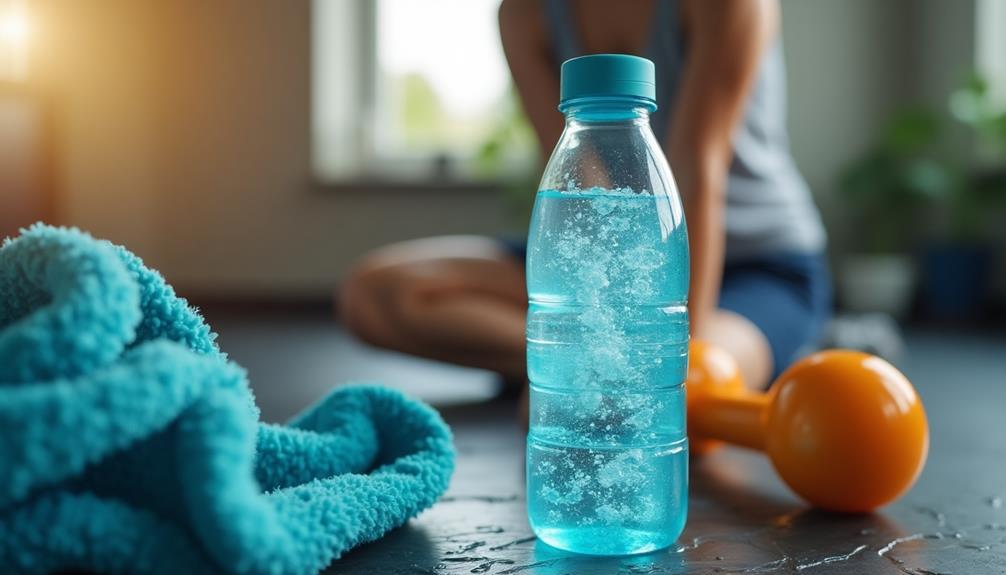To effectively manage soreness post-strength training, follow these five essential tips. First, keep hydrated—drink water throughout your workout and aim for half your body weight in ounces daily. Second, integrate active recovery like light jogging or yoga to promote blood flow. Third, emphasize nutrition by including protein and healthy fats in your post-workout meals. Fourth, utilize foam rollers to relieve tight muscles and improve circulation; spend 1-2 minutes on each sore area. Finally, make sure you obtain enough sleep—7 to 9 hours nightly will aid recovery. These steps can enhance your recovery journey and keep your workouts effective.
Core Insights
- Stay hydrated by drinking water before, during, and after workouts to reduce muscle soreness and aid recovery.
- Incorporate active recovery activities like jogging or yoga to promote blood flow and speed up muscle repair.
- Prioritize nutrition with sufficient protein and carbohydrates post-workout to support muscle repair and replenish energy stores.
- Use foam rollers to relieve tightness and improve circulation, spending 1-2 minutes on each muscle group.
- Ensure 7 to 9 hours of quality sleep each night to facilitate muscle repair and restore energy levels.
Stay Hydrated

To combat soreness after strength training, you need to prioritize hydration. Water plays a vital role in your recovery process. When you exercise, your body loses fluids through sweat. If you don't replenish those fluids, it can lead to dehydration, which can increase muscle soreness. Some brain health supplements can also help improve focus and cognitive function during workouts, potentially enhancing your overall performance and recovery.
Aim to drink water before, during, and after your workouts. A good rule of thumb is to consume at least half your body weight in ounces daily. For example, if you weigh 150 pounds, aim for 75 ounces of water.
Incorporating electrolyte-rich drinks can also be beneficial, especially after intense sessions. These drinks help restore essential minerals lost during sweating. By staying well-hydrated, you'll support muscle recovery, reduce soreness, and enhance overall performance.
Incorporate Active Recovery

Active recovery is a powerful tool for managing soreness after strength training. Instead of complete rest, incorporate low-intensity activities that help promote blood flow and ease discomfort. This approach aids in muscle repair while keeping you active. Compression sleeves can also be beneficial during active recovery, providing targeted support and enhancing circulation to promote faster healing. For ideal results, choose sleeves with appropriate compression levels based on your needs. Here are some effective active recovery options you can try:
- Light jogging or brisk walking
- Cycling at a relaxed pace
- Swimming or water aerobics
- Gentle yoga or stretching sessions
- Foam rolling or using a massage ball
Prioritize Nutrition

Nutrition plays a key role in managing soreness after strength training. To support your recovery, focus on consuming sufficient protein. Protein helps repair and build muscle, reducing soreness. Aim for a post-workout meal or snack that includes protein within 30 to 60 minutes after exercising. Consider incorporating vitamin D3 supplements to support muscle health and enhance recovery. Vitamin D3 has been shown to aid in calcium metabolism and reduce the risk of deficiencies that can impact athletic performance.
Also, don't forget about carbohydrates. They replenish your glycogen stores, providing the energy needed for recovery. Include healthy fats in your diet as well, as they can help reduce inflammation.
Stay hydrated too; water is essential for muscle function and recovery. Lastly, consider incorporating anti-inflammatory foods like berries, leafy greens, and fatty fish into your meals. By prioritizing nutrition, you'll not only manage soreness better but also enhance your overall performance.
Use Foam Rollers

Foam rollers can be a game-changer for managing soreness after strength training. They help relieve muscle tightness and improve blood flow, which can speed up recovery. Using a foam roller is simple, and you can easily incorporate it into your routine.
Here are some tips for effective foam rolling:
- Target sore areas: Focus on muscles that feel tight or tender.
- Use your body weight: Apply pressure by rolling slowly over the roller.
- Breathe deeply: Inhale and exhale to help relax your muscles.
- Roll for 1-2 minutes: Spend adequate time on each muscle group.
- Combine with stretching: Follow foam rolling with gentle stretches for enhanced relief.
Incorporating foam rolling into your post-training routine can significantly reduce soreness.
Get Enough Sleep

Sleep is an essential factor in managing soreness after strength training, and getting enough of it can make a significant difference in your recovery. When you sleep, your body repairs damaged muscle fibers and restores energy levels. Aim for 7 to 9 hours of quality sleep each night to support peak recovery.
Establish a consistent sleep schedule by going to bed and waking up at the same time daily. Create a relaxing bedtime routine to signal your body that it's time to wind down. Limit screen time before bed, as blue light can interfere with your sleep quality. Lastly, make sure your sleep environment is comfortable, dark, and cool. By prioritizing sleep, you'll enhance your recovery and reduce post-workout soreness effectively.
Frequently Asked Questions
How Long Does Post-Strength Training Soreness Typically Last?
Post-strength training soreness usually lasts between 24 to 72 hours. You might feel discomfort peaking around the second day, but don't worry; it's a normal response as your muscles adapt and recover.
Is Soreness a Sign of Effective Strength Training?
You might think soreness signals effective strength training, but it isn't the only indicator. Instead, focus on your progress, strength gains, and overall performance, as these elements reveal your workout's true effectiveness and benefits.
Can I Continue Training With Soreness Present?
You can continue training with some soreness, but listen to your body. Adjust your intensity, focus on different muscle groups, and guarantee proper recovery. Don't push too hard; it's important to avoid injury.
Are There Supplements That Help Reduce Muscle Soreness?
When muscle soreness feels like a storm raging inside you, certain supplements can act as your calm. Omega-3s, creatine, and branched-chain amino acids might just help ease that storm and speed your recovery.
How Does Age Affect Muscle Soreness Recovery?
Age can slow your muscle recovery, making soreness last longer. As you get older, your body's ability to repair tissue decreases, so you might need more time and care to bounce back after workouts.

